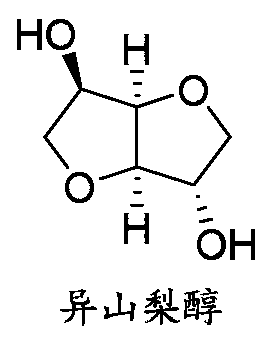Isosorbide-modified high-heat-resistance biodegradable polyester and preparation method thereof
A technology for biodegrading polyester and isosorbide, applied in the field of polyester materials, can solve problems such as non-biodegradability, and achieve the effects of high isosorbide grafting rate, optimized synthesis process, and good hue.
- Summary
- Abstract
- Description
- Claims
- Application Information
AI Technical Summary
Problems solved by technology
Method used
Image
Examples
preparation example Construction
[0049] A preparation method of high heat-resistant biodegradable polyester, comprising the following steps:
[0050] 1) Esterification reaction: Add terephthalic acid and / or dialkyl terephthalate, 40-60% straight-chain fatty diol, isosorbide, catalyst and stabilizer into the reaction kettle , use an inert gas to remove the air in the reactor and then raise the temperature to 230-260°C, carry out the first-stage esterification reaction under the pressure of 3MPa until there is no distillate; then cool down to 150-210°C, and add directly under the protection of nitrogen Chain aliphatic dicarboxylic acid and / or its dialkyl ester and / or its anhydride, and the remaining straight-chain aliphatic dihydric alcohol, continue to esterify under normal pressure until the amount of distillate reaches more than 90% of the theoretical value, then enter the next step polycondensation reaction.
[0051] 2) Polycondensation reaction: After the esterification reaction is completed, slowly vacuu...
Embodiment 1
[0054] 1) Esterification reaction: Add 664.52g of terephthalic acid, 121.04g of ethylene glycol, 374.12g of isosorbide, 0.016g of stannous isooctanoate and 0.21g of trimethyl phosphate into a 2.5L reaction kettle, and exhaust with nitrogen After the air in the reactor is warmed up to 260°C, the esterification reaction of the first stage is carried out until there is no distillate; then the temperature is lowered to 210°C, and 118.09g of succinic acid and the remaining 121.04g of ethylene glycol are added under the protection of nitrogen, usually The esterification is continued under pressure until the amount of distillate reaches more than 90% of the theoretical value.
[0055] 2) Polycondensation reaction: After the esterification reaction is completed, vacuumize slowly to remove excess glycol, and the vacuum degree reaches the maximum in about 1 hour. While evacuating, the temperature was raised to 220°C. Continue to keep the vacuum to react below 60Pa, and discharge the ma...
Embodiment 2
[0057] 1) Esterification reaction: 776.72g dimethyl terephthalate, 121.04g ethylene glycol, 374.12g isosorbide, 0.016g stannous octoate and 0.21g trimethyl phosphate were added to a 2.5L reaction kettle, Exclude the air in the reactor with nitrogen, then raise the temperature to 250°C to carry out the first stage esterification reaction until there is no distillate; then cool down to 210°C, add 118.09g of succinic acid and the remaining 121.04g of ethylene glycol under the protection of nitrogen Alcohol, under normal pressure, continue to esterify until the amount of distillate reaches more than 90% of the theoretical value.
[0058] 2) Polycondensation reaction: After the esterification reaction is completed, vacuumize slowly to remove excess glycol, and the vacuum degree reaches the maximum in about 1 hour. While evacuating, the temperature was raised to 220°C. Continue to keep the vacuum to react below 60Pa, and discharge the material after the reaction finishes.
PUM
 Login to View More
Login to View More Abstract
Description
Claims
Application Information
 Login to View More
Login to View More - Generate Ideas
- Intellectual Property
- Life Sciences
- Materials
- Tech Scout
- Unparalleled Data Quality
- Higher Quality Content
- 60% Fewer Hallucinations
Browse by: Latest US Patents, China's latest patents, Technical Efficacy Thesaurus, Application Domain, Technology Topic, Popular Technical Reports.
© 2025 PatSnap. All rights reserved.Legal|Privacy policy|Modern Slavery Act Transparency Statement|Sitemap|About US| Contact US: help@patsnap.com

